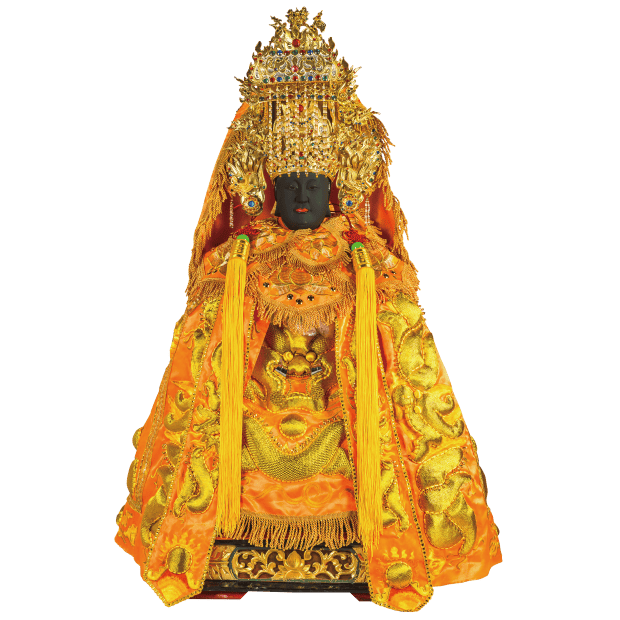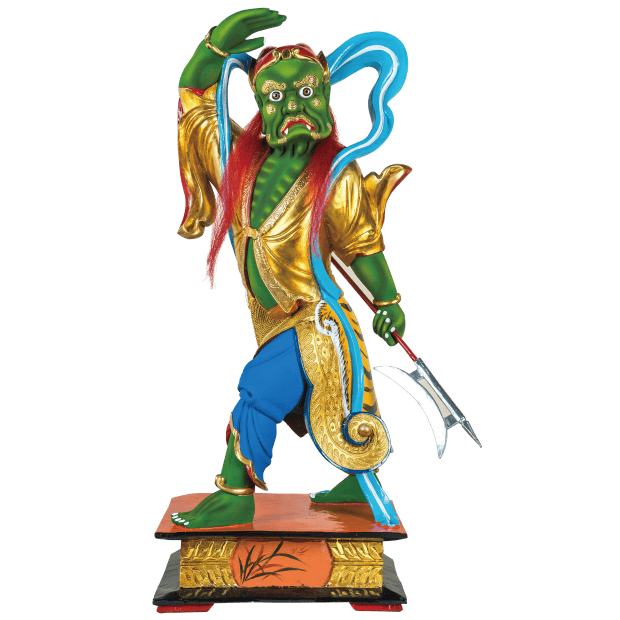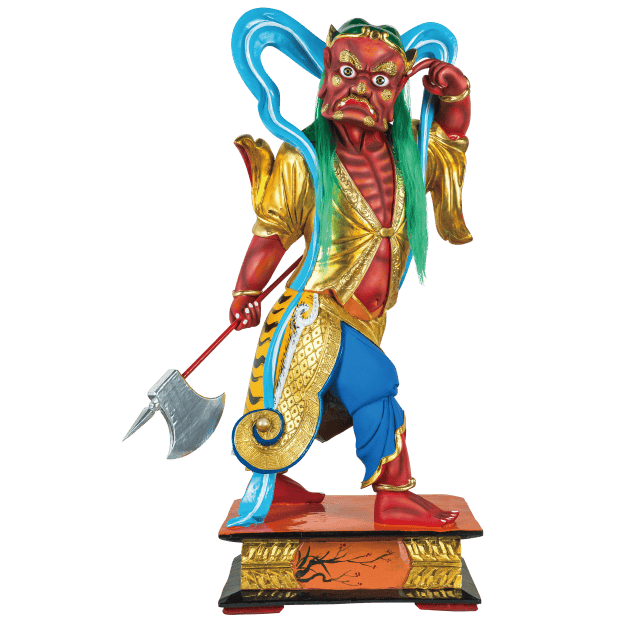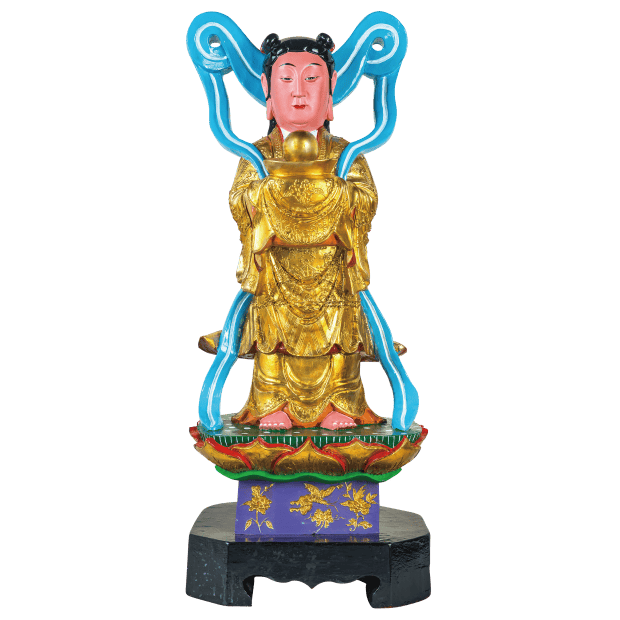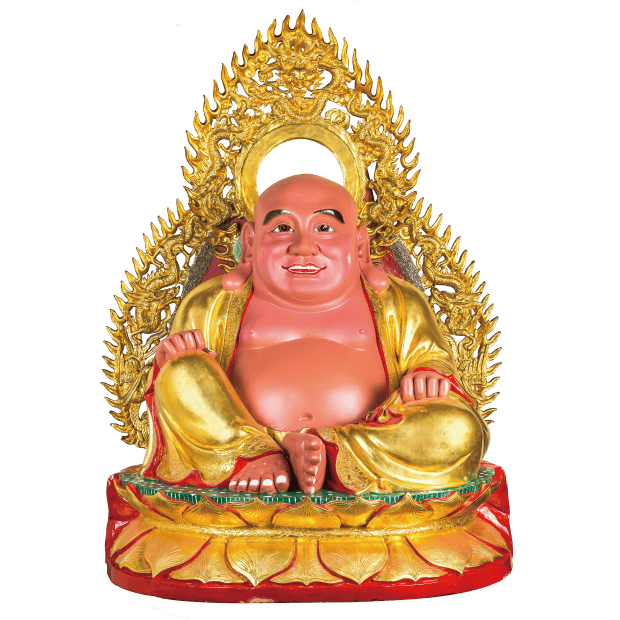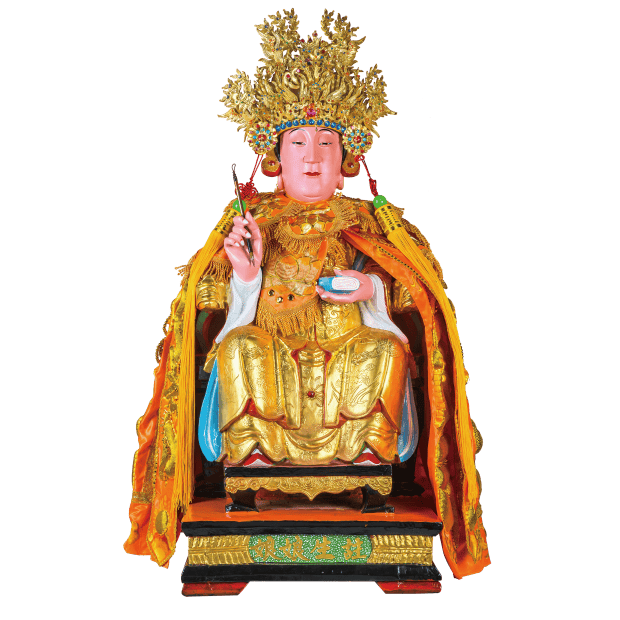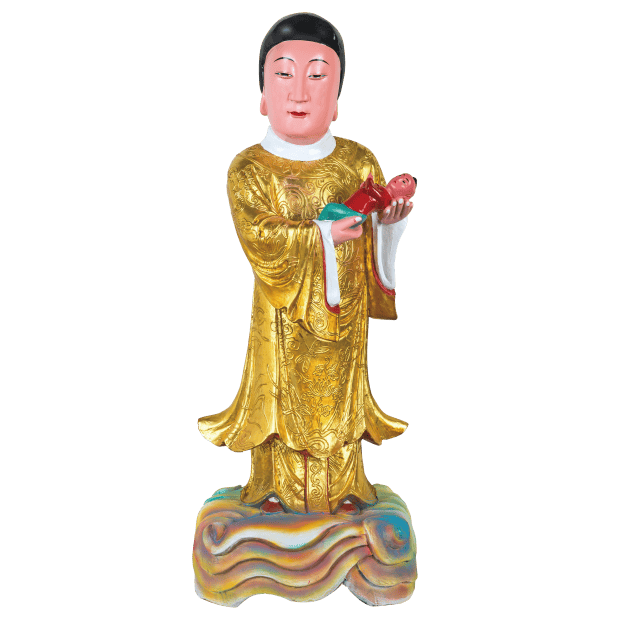First Floor - West Wing
-
Read More
 Sacred Mother of Heaven
Sacred Mother of HeavenSacred Mother of Heaven
♦Sacred birth celebrated on the 23rd day of the 3rd lunar month♦
Lin Muo Niang is the secular name of the Sacred Mother of Heaven. A native of Meizhou Island in Putian County, Xinghua Prefecture in Fujian Province, she often revealed her divinity by flying over the seas to save mortals. To memorialize her gracious deeds, the people of Meizhou constructed temples to worship her and honored her with the title “A Woman of Spirituality and Virtue.” In winter of the 25th year of the Emperor Gaozong of Song’s Shaoxing Era, she was given the title of “Lady Chonggu” by imperial decree, and established by later dynasties as imperial consort, heavenly consort, heavenly empress, and the Sacred Mother of Heaven with 24 lives. In many regions in Taiwan, the Sacred Mother is known as “Mazu.” -
Read More
 Qianliyan (Thousand-Mile Eyes)
Qianliyan (Thousand-Mile Eyes)Qianliyan (Thousand-Mile Eyes)
♦Sacred birth celebrated on the same day as the Sacred Mother of Heaven ♦
A guardian deity guarding the throne of the Sacred Mother of Heaven, Qianliyan has a blue face, and fangs. He assists Mazu in keeping watch for crises among mortals across great distances. -
Read More
 Shunfeng’er (Ears that Listen with the Wind)
Shunfeng’er (Ears that Listen with the Wind)Shunfeng’er (Ears that Listen with the Wind)
♦Sacred birth celebrated on the same day as the Sacred Mother of Heaven♦
A guardian deity guarding the throne of the Sacred Mother of Heaven, Shunfeng’er has a rubicund face and fangs, his ears listen for the pleas from the mortal realm that are carried in the wind. -
Read More
 Guanyin Ancestral Buddha
Guanyin Ancestral BuddhaGuanyin Ancestral Buddha
♦Sacred birth celebrated on the 19th day of the 2nd lunar month♦
Originally named “Guanyin Bodhisattva,” “Guanyin” is the sacred name whole Ancestral Buddha is a folk honorific bestowed on the buddha. Guanyin’s sacred name was originally “Guanshiyin” but the sacred name was shortened during the Tang Dynasty to avoid using the same character shared in the name of Emperor Li Shimin. According to the Mahayana Buddhist Scriptures, some Bodhisattvas had already attained Buddhahood in ancient times. They appear in their Buddha form when they enter the mortal realm to enlighten the people and save them from suffering. Guanshiyin Bodhisattva is among these. Buddhist scriptures describe Guanshiyin Bodhisattva as having a vast compassionate heart. When the name Guanshiyin Bodhisattva is evoked, the Bodhisattva would seek out those who call out to relieve their suffering and help them find joy, hence, people refer to “compassionate and benevolent Guanyshiyin Bodhisattva”, as the most renown of the major buddhas in Buddhism, with the accolade of “in every home Amitabha; in every family Guanshiyin.” -
Read More
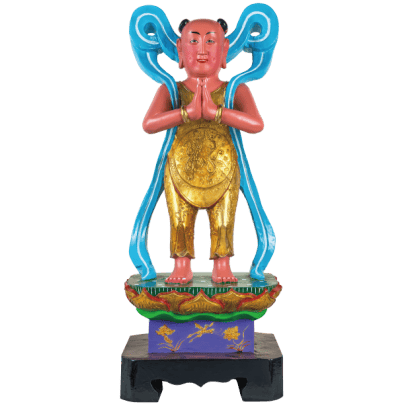 Sudhana (Child of Wealth)
Sudhana (Child of Wealth)Sudhana (Child of Wealth)
♦Sacred birth celebrated on the same day as Guanyin Ancestral Buddha♦
Natural treasures flowed forth when this disciple of the bodhisattva was born, hence he was given this name. He is the protagonist in the work Avataṃsaka Sūtra, and is a radiant exemplar for those practicing the way of the Buddha. After initiating the Anuttara Samak Sambodhi heart, he gradually traveled southward from where Manjusri bodhisattva was, visiting 53 Kalyāṇa-mitra benevolent advisors before completing his spiritual cultivation and entering the Dharma Realm. The smiling boy child who stands next to Guanyin Bodhisattva in the mural of Guanyin in most altar rooms is Sudhana. And on the other side of Guanyin is Dragon Girl ārya. The duo together is referred to as Child of Wealth and Girl of Jade. -
Read More
 Longnü (Dragon Girl)
Longnü (Dragon Girl)Longnü (Dragon Girl)
♦Sacred birth celebrated on the same day as Guanyin Bodhisattva♦
Originally the daughter of Sāgara the Dragon King, Longnu is an attendant of Guanyin Bodhisattva. She and Sudhana (Child of Wealth) stand on either side of the bodhisattva. In the Devadatta section of the Lotus Sutra, Longnu is said to have achieved dharma by the age of eight. Despite being questioned by the Venerable Shariputra, she still attained Buddhahood at the Dharma Assembly. In order to demonstrate the compassion of Buddhist teachings, and to assist Guanshiyin Bodhisattva in saving sentient beings in the six realms, Longnu appears in the form of a girl child, and along with Sudhana, they are the left- and right-hand attendants of Guanshiyin bodhisattva, and are known collectively as “Golden Boy and Jade Girl.” -
Read More
 Maitreya Ancestral Buddha
Maitreya Ancestral BuddhaMaitreya Ancestral Buddha
♦Sacred birth celebrated on the 1st day of the 1st lunar month ♦
Maitreya bodhisattva is the “Laughing Buddha” of Buddhism. His family name is Ajitas. Maistreya is his Sanskrit name that is roughly translated as “compassionate.” “Maitreya Bodhisattva” is a “buddha for the future, who resides and leads the heavens. He obsessively observes the world and has entered the mortal realm in disguise. Legends say that during the fifth dynasty, he was incarnated in the form of a monk named Budai (lit. “cloth sack”), referring to himself as “Son of Changting.” It is often said: “Maitreya the true Maitreya has been taken myriad forms, always showing himself to the world yet the world does not recognize him.” -
Read More
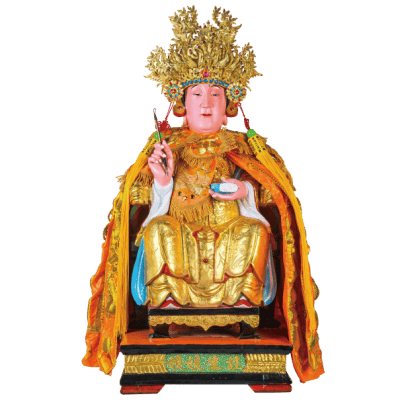 Goddess of Childbirth (Zhusheng Niang Niang)
Goddess of Childbirth (Zhusheng Niang Niang)Goddess of Childbirth (Zhusheng Niang Niang)
♦Sacred birth celebrated on the 12th day of the third lunar month ♦
The Goddess of Childbirth (colloquially referred to as “Mother of Childbirth”) is the deity of fertility as well as the deity who protects pregnant and post-partem women, new born children, and the infertile. She is often depicted as holding a book in her left hand and a brush in the right hand, symbolizing the documentation of offspring in each household and family. As recorded in Investiture of the Gods (Fengshen Yanyi), she was created by three female immortals, Yunxiao, Bixiao, and Qiongxiao, all acolytes of the Sacred Mother of the Turtle Spirit. The Goddess of Childbirth is also known as “The Child-Giving God.” Her 12 female attendants are known as the 12 governesses. -
Read More
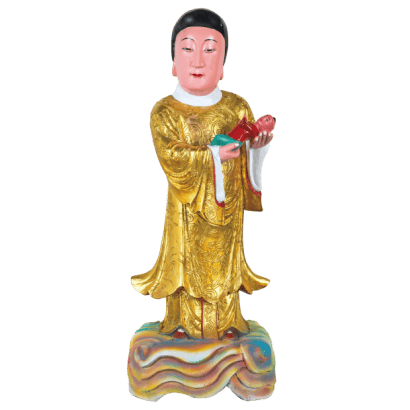 Twelve Governesses
Twelve GovernessesTwelve Governesses
♦Sacred birth celebrated on the same day as the Goddess of Childbirth ♦
As recorded in the Notes from Fujian Min Section, Chen Jinggu gained proficiency in various Tao methods from Master Xu Jenjun, and assisted Wang Tingbin, King of the Min in resolving a crisis of demons to rescue the Empress and 36 courtesans. In gratitude, King of the Min assigned the 36 courtesans as disciples of Chen Queen Mother. Known as the 36 Governesses, they are each able to exorcise demons, resolve misfortune, rescue women in childbirth, protect fetuses and deliver children. Each year on the 15th day of the first lunar month, the 36 governesses are divided in to three teams. They answer prayers, and encourage the faithful to do good and avoid evil, winning the hearts of the people. In Taiwanese folk belief, the 12 governesses can cure women’s illnesses as well as look after the food, clothing, shelter, movement, fearfulness, night crying, and illnesses in children. The governesses are gods of birth and nurture, and flank the Goddess of Childbirth as her attendants.

